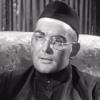 Submitted by Dr. Aadesh Kumar on
Submitted by Dr. Aadesh Kumar on
By Nomu420 - Own work, CC BY-SA 3.0, https://commons.wikimedia.org/w/index.php?curid=32744844
Indra (/ˈɪndrə/, Sanskrit: इन्द्र) is a Vedic deity in Hinduism, a guardian deity in Buddhism, and the king of first heaven called Saudharmakalpa in Jainism.
He is one of the main gods of the Rigveda and is the Indo-European cousin of the German Wotan, Norse Odin, Greek Zeus, and Roman Jupiter. In early religious texts, Indra plays a variety of roles.
In the Vedas, Indra is the king of the Devas. He is the god of lightning, thunder, storms, rains and river flows. Indra is the most referred to deity in the Rigveda. He is celebrated for his powers, and the one who kills the great symbolic evil named Vritra who obstructs human prosperity and happiness. Indra destroys Vritra and his "deceiving forces", and thereby brings rains and the sunshine as the friend of mankind. His importance diminishes in the post-Vedic Indian literature where he is depicted as a powerful hero but one who is getting in trouble with his drunken, hedonistic and adulterous ways, and the god who disturbs Hindu monks as they meditate because he fears self-realized human beings may become more powerful than him.
In Buddhism, Indra has been a popular deity, referred by many names and particularly Shakra (Pali: Sakka). He is featured in Buddhism somewhat differently than Hinduism, such as being shown as less war oriented and one paying homage to the Buddha. Indra rules over the much sought Devas realm of rebirth within the Samsara doctrine of Buddhist traditions. However, like the Hindu texts, Indra also is a subject of ridicule and reduced to a figurehead status in Buddhist texts,shown as a god that suffers rebirth and redeath. In the Jainism traditions, like Buddhism and Hinduism, Indra is the king of gods and a part of Jain rebirth cosmology. He is also the god who appears with his wife Indrani to celebrate the auspicious moments in the life of a Jain Tirthankara, an iconography that suggests the king and queen of gods reverentially marking the spiritual journey of a Jina.
Indra's iconography shows him wielding a lightning thunderbolt known as Vajra, riding on a white elephant known as Airavata. In Buddhist iconography the elephant sometimes features three heads, while Jaina icons sometimes show the elephant with five heads. Sometimes a single elephant is shown with four symbolic tusks. Indra's heavenly home is on or near Mount Meru (also called Sumeru).
Indra is of ancient but unclear origin. Aspects of Indra as a deity are cognate to other Indo-European gods; they are either thunder gods such as Thor, Perun, and Zeus who share parts of his heroic mythologies, act as king of gods, and all are linked to "rain and thunder". The similarities between Indra of Hindu mythologies and of Thor of Nordic and Germanic mythologies are significant states Max Muller. Both Indra and Thor are storm gods, with powers over lightning and thunder, both carry hammer or equivalent, for both the weapon returns to their hand after they hurl it, both are associated with bulls in the earliest layer of respective texts, both use thunder as a battle-cry, both are heroic leaders, both protectors of mankind, both are described with legends about "milking the cloud-cows", both are benevolent giants, god of strength, of life, of marriage and the healing gods, both are worshipped in respective texts on mountains and in forests.
Indra is praised as the highest god in 250 hymns of the Rigveda – a Hindu scripture dated to have been composed sometime between 1700 to 1100 BCE. He is co-praised as the supreme in another 50 hymns, thus making him one of the most celebrated Vedic deities.] He is also mentioned in ancient Indo-Iranian literature, but with a major inconsistency when contrasted with the Vedas. In the Vedic literature, Indra is a heroic god. In the Avestan (ancient, pre-Islamic Iranian) texts such as Vd. 10.9, Dk. 9.3 and Gbd 27.6-34.27, Indra – or accurately Andra – is a gigantic demon who opposes truth. In the Vedic texts, Indra kills the archenemy and demon Vritra who threatens mankind. In the Avestan texts, Vritra is not found.
Indra is called vrtrahan- (literally, "slayer of Vritra demon") in the Vedas, which corresponds to Verethragna of the Zoroastrian noun verethragna-. According to David Anthony, the Old Indic religion probably emerged among Indo-European immigrants in the contact zone between the Zeravshan River (present-day Uzbekistan) and (present-day) Iran. It was "a syncretic mixture of old Central Asian and new Indo-European elements", which borrowed "distinctive religious beliefs and practices" from the Bactria–Margiana Culture.
In Rigveda, Indra is described as strong willed, armed with thunderbolt, riding a chariot:
May the strong Heaven make thee the Strong wax stronger: Strong, for thou art borne by thy two strong Bay Horses. So, fair of cheek, with mighty chariot, mighty, uphold us, strong-willed, thunder armed, in battle.
— RigVeda, Book 5, Hymn XXXVI: Griffith
Indra's weapon, which he used to kill evil Vritra, is the Vajra or thunderbolt. Other alternate iconographic symbolism for him includes a bow (sometimes as a colorful rainbow), a sword, a net, a noose, a hook, or a conch. The thunderbolt of Indra is called Bhaudhara.
https://ipfs.io/ipfs/QmXoypizjW3WknFiJnKLwHCnL72vedxjQkDDP1mXWo6uco/wiki/Indra.html